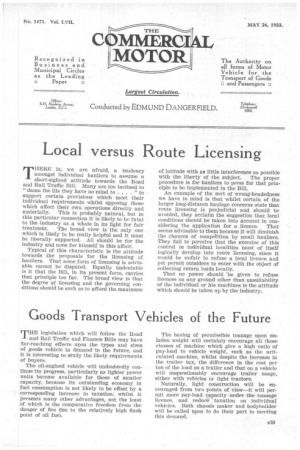Goods Transport Vehicles of the Future
Page 33

Page 34

If you've noticed an error in this article please click here to report it so we can fix it.
THE legislation which will follow the Road and Rail Traffic and Finance Bills may have far-reaching effects upon the types and sizes of goods vehicle in demand In the future, and it is interesting to study the likely requirements of buyers.
The oil-engined vehicle will undoubtedly continue its progress, particularly as lighter power units become available for those of smaller capacity, because its outstanding economy in fuel consumption is not likely to be offset by a corresponding increase in taxation; whilst it presents many other advantages, not the least of which is the comparative freedom from the danger of fire due to the relatively high flash point of oil fuel. The basing of permissible tonnage upon unladen weight will certainly encourage all those classes of machine which give a high ratio of pay-load to vehicle weight, such as the articulated machine, whilst despite the increase in the trailer tax, the difference in the cost per ton of the load on a trailer and that on a vehicle will unquestionably encourage trailer usage, either with vehicles or light tractors.
Naturally, light construction will be encouraged from two points of view—it will permit more pay-load capacity under the tonnage licence, and reduce taxation on individual vehicles. Both chassis maker and bodybuilder will be called upon to do their part in meeting this demand.
The Progress of Commercial Vehicle Design
OMMERCIAL motor chassis design, in some of its aspects, moves in cycles : perhaps it would be more accurate to state that its progress is harmonic. In the beginning, touring car chassis were deemed to be suitable for goods conveyance. That was a very brief phase. Then, commercial motor chassis, developed independently of touring cars, were used alike for goods and passengers. Passenger-vehicle requirements were next discovered to be special and in their design diverged from that of chassis for goods. The advent of the giant pneumatic tyre gave an impetus, at its outset, to this specialized development of the passenger vehicle. As the use of pneumatic tyres for goods vehicles developed it was discovered that many of the special features of passenger chassis had become capable of adaptation for use on goods vehicles, to their betterment. Many of the latest types of heavy vehicle chassis are now considered to be equally suitable for goods and passengers.
Now, in the latest phase—completing the cycle —commercial vehicle chassis and complete vehicles are approaching touring cars in respect of many of their features, features which, a little while ago, would have been deemed luxurious and even extravagant in that connection. The use of six-cylindered engines, twintop gearboxes or those embodying synchronized meshing devices, shock absorbers and the provision of drivers' cabs hardly less luxurious than expensive saloons or coupes are indications of this trend.
Throughout, withal, there is this single under lying characteristic. The desire to provide chassis which will best meet the needs of the user in respect of performance, safety, reliability, load capacity, speed and, most of all, economical operation. The progress may be in cycles, but it is progress nevertheless.
Increase the Income Tax Allowance
A N excellent case can now be put forward to -171-the Income Tax Commissioners for an increase in the allowance which is made in respect of commercial vehicles. At present, the allowance is 20 per cent., but this is not upon the capital outlay, except during the first year, but on the depreciating value.
In any case, the economic life of a hardworked vehicle cannot now be considered as five years, and this will apply with even greater force to the comparatively lightly built machines which are likely to be sold in increasing numbers as a result of the coming legislation. Those medium-capacity vehicles which will have to pay higher taxation will have to work intensively to offset the heavier expenditure, and it cannot be expected that they will stand up for such a long period.
We suggest, therefore, that the allowance should be either increased to 33i per cent. or be retained at 20 per cent., with the latter figure applied to the capital cost of the vehicle and not to its depreciating value.
We strongly recommend that this matter should receive early attention and the case be laid before the revenue authorities either immediately or, at the latest, when the taxation for the coming year is finally approved.




























































































